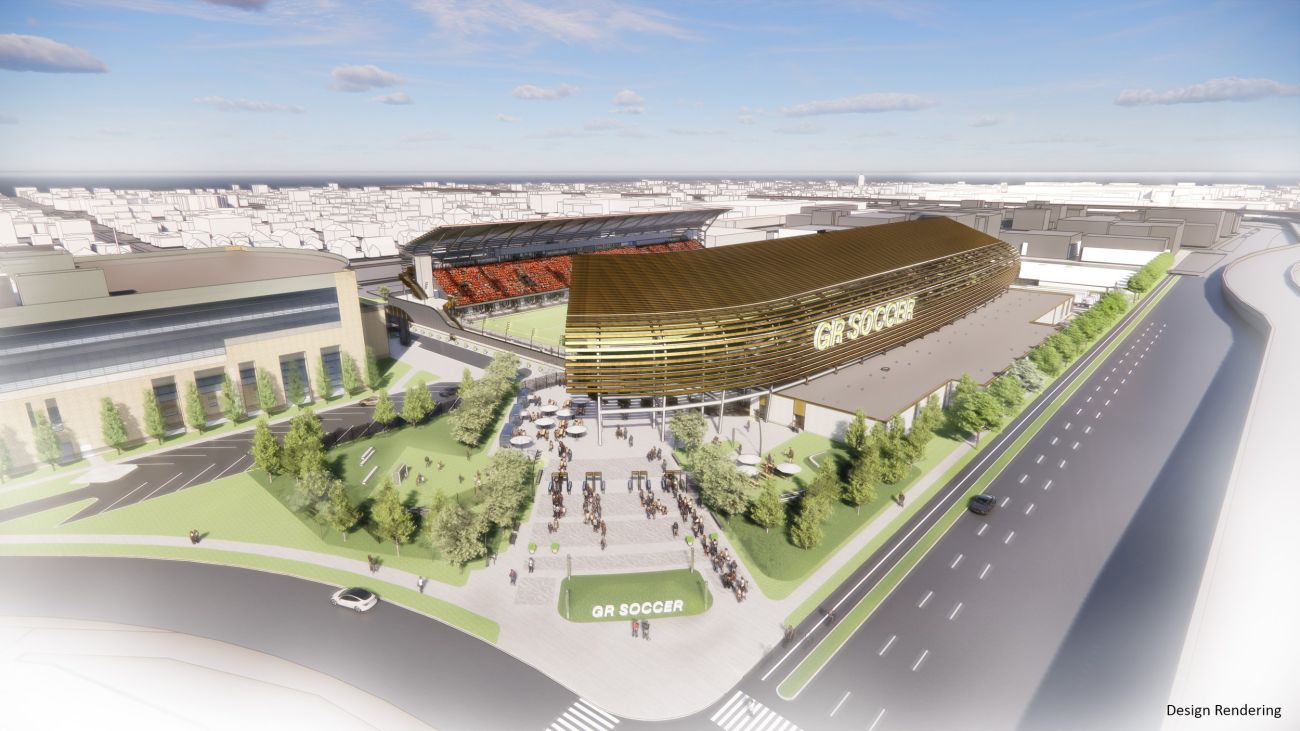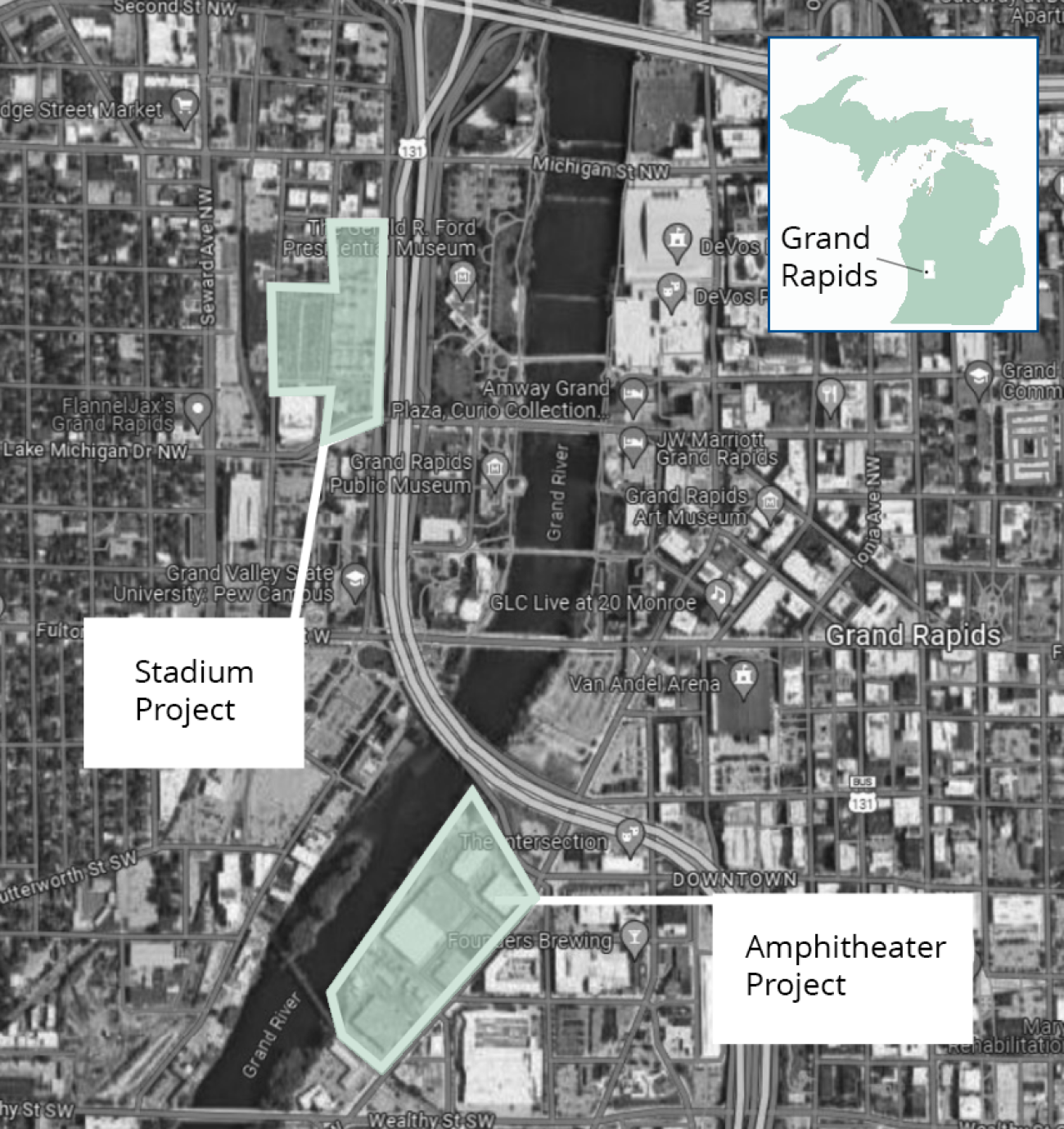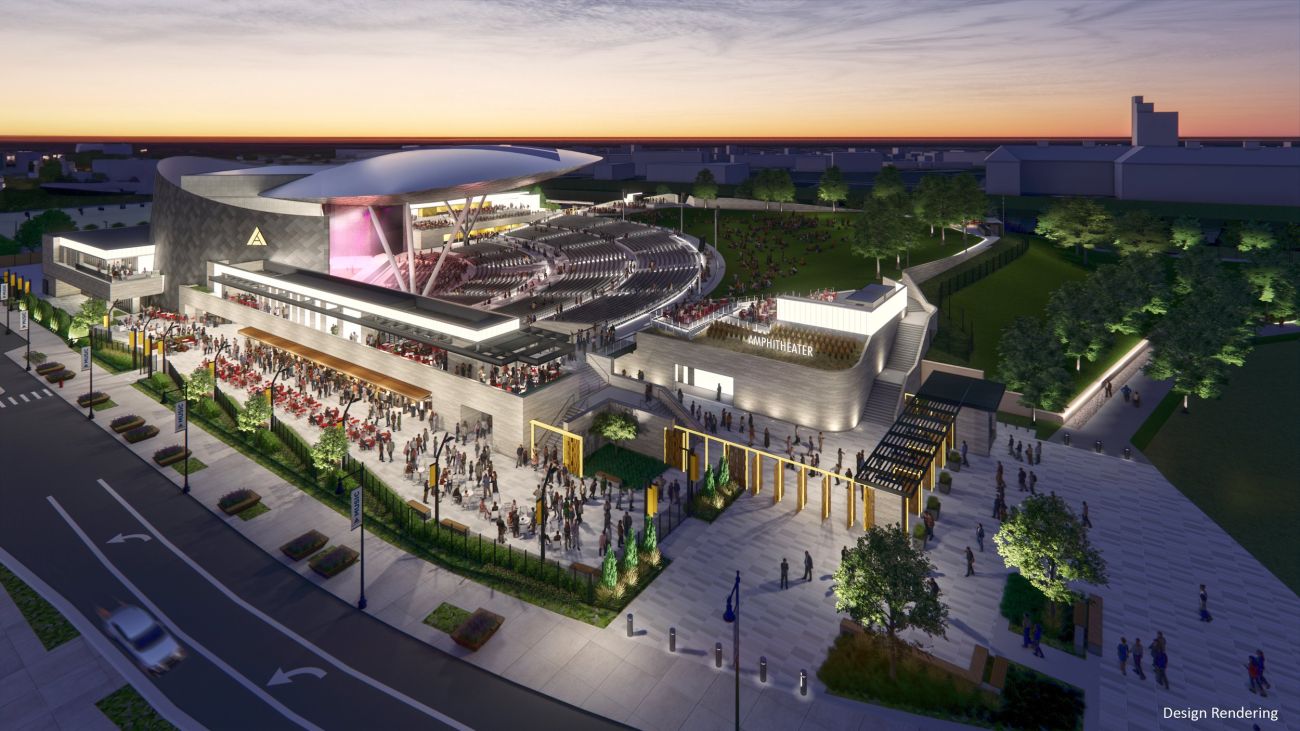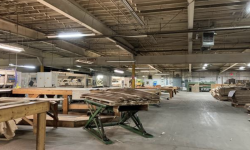$700M plan to 'transform' Grand Rapids with soccer arena, concert districts

- Michigan awarded public funding to a years-long plan to add entertainment venues in downtown Grand Rapids
- The state on Tuesday approved a ‘transformational brownfield’ plan, allowing up to $252 million in tax gains to fund development costs
- Several community partners support the new amphitheater and soccer arena, saying they will remake the city’s waterfront district
Grand Rapids is counting on two ambitious new downtown entertainment venues to drive growth — in tourism, new housing and other spending — to support the $700 million backers say they will spend to build them.
The plan calls for two mixed-use districts divided by roughly a half-mile and the Grand River, one anchored by a new soccer stadium and the other by a riverfront amphitheater. Each district is expected to feature parking, housing and other amenities.
The venue districts will be near earlier downtown developments — including Van Andel Arena and the DeVos Performance Hall — that just a few decades ago turned Michigan’s second-largest city into an entertainment destination.
This time, developers are looking at bringing pro soccer to town, building 735 apartments and extending the downtown commercial district closer to the riverfront.

The plan, made public in 2021, received a commitment for up to $252 million in public funding on Tuesday, as the Michigan Strategic Fund approved a transformational brownfield plan for the sites. Under the plan, increases in property, sales and income tax revenue that come as a result of the project will be used to reimburse the developer, in a process known as tax capture.
Related:
- Michigan is helping train EV tech workers. Do their jobs exist yet?
- Michigan minimum wage increase is ‘nightmare’ for restaurants, industry says
- Housing squeezes bustling Traverse City. Are rehabbed warehouses an answer?
The new venues are a once-in-a-lifetime plan that “will generate long-lasting community and cultural enhancements,” according to the state as it sought the award from the strategic fund board, the public funding arm of the Michigan Economic Development Corporation.
The investment by the state and the developer is significant, MEDC CEO Quentin Messer said Tuesday, promising “transformation of the Grand Rapids riverfront.”

The 12,160-seat Acrisure Amphitheater now under construction south of downtown is expected to anchor a riverside makeover south of downtown. Eventually housing, a greenway and maybe even zip lines will add recreational uses to the area. (Courtesy image)
The plans include:
- The 12,160-seat Acrisure Amphitheater next to the Grand River at Market Avenue, alongside a publicly owned riverwalk that will be constructed between the venue and the river. The project, already under construction, eventually is expected to include 475 apartments with a six-story parking garage.
- An 8,500-seat soccer stadium located west of downtown on the edge of Grand Valley State University’s Grand Rapids campus. An 18-story commercial tower is planned for property immediately to the north of the stadium, with stores, restaurants, offices and 260 apartments.
Developer Grand Action 2.0 leadership includes Dick DeVos and Carol Van Andel, business and philanthropy kingpins with legacy downtown developments that include the DeVos Place Convention Center, the Van Andel Arena and the Downtown Market.
The not-for-profit company spent years outlining the vision, building the foundation for Tuesday’s public financing vote.
That financing is complicated, and contains some provisions that could result in revisions, the state said, including if the project expenses are lower than expected.
The $252 million state award of public funding includes $97.6 million in state and local property tax revenue, about $43.2 million of which will come from the city, according to strategic fund documents. The city authorized an additional $31.1 million in tax abatements by creating a tax-free Neighborhood Enterprise Zone.
Another $128 million will reimburse the developer after construction concludes, according to the documents.
Grand Action 2.0 is expected to contribute 20%, or about $140 million, to the project, with the rest financed by loans, according to strategic fund board documents. The developer also is responsible for site cleanup, the state said.
A menu of partners will drive other aspects of the project, including the city’s Downtown Development Authority, the Grand Rapids-Kent County Convention/Arena Authority and still-undetermined private developers expected to take the lead on each piece of the mixed-use components.
Tuesday’s vote to approve the transformational brownfield plan — one of just a handful of similar high-dollar tax-capture projects in the state — came after a series of public votes to make the funding and early steps of the project possible.
They include the city authorizing the tax capture, the parking ramp at the amphitheater and the plans for the stadium. This month, Kent County voters OK’d an increase in the accommodation tax from 5% to 8% to grow revenue from the 2.1 million annual hotel visits in the region per year.
The vote toward establishing a new soccer venue comes as Detroit City Football Club is planning on building a stadium in the Corktown neighborhood.
Stadium deals have been controversial when they involve public funding, including in Detroit. For the largest deals, few show fiscal returns to the public, though teams generate significant regional spending on game days.
In Grand Rapids, estimates from independent consultants suggest that the developers can anticipate a 7-8% return on investment, based on analysis that assumes no debt, according to strategic fund documents. That makes the state funding key to the deal, the strategic fund said.
Meanwhile, the state has set up limits on how much tax funding can be returned to the developers, with 50% available until they finalize an affordable housing agreement with the city.
The complexity of the deal led Grand Action 2.0 Executive Director Kara Wood to say Tuesday that the “project has been a true community collaboration.”
Participants, Wood said, “understand the magnitude of the generational impact this project will have on our community.”
Business Watch
Covering the intersection of business and policy, and informing Michigan employers and workers on the long road back from coronavirus.
- About Business Watch
- Subscribe
- Share tips and questions with Bridge Business Editor Paula Gardner
Thanks to our Business Watch sponsors.
Support Bridge's nonprofit civic journalism. Donate today.
See what new members are saying about why they donated to Bridge Michigan:
- “In order for this information to be accurate and unbiased it must be underwritten by its readers, not by special interests.” - Larry S.
- “Not many other media sources report on the topics Bridge does.” - Susan B.
- “Your journalism is outstanding and rare these days.” - Mark S.
If you want to ensure the future of nonpartisan, nonprofit Michigan journalism, please become a member today. You, too, will be asked why you donated and maybe we'll feature your quote next time!




